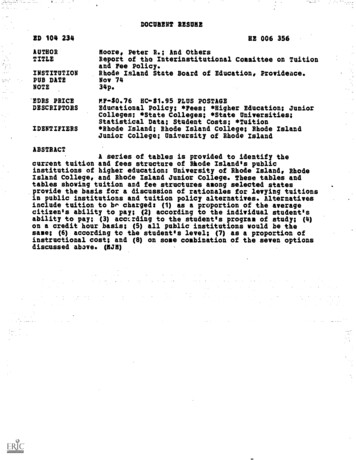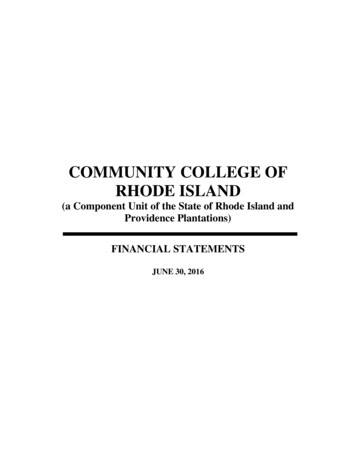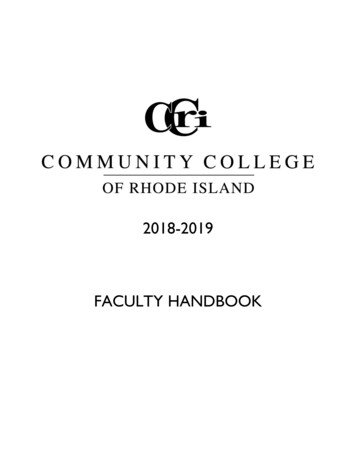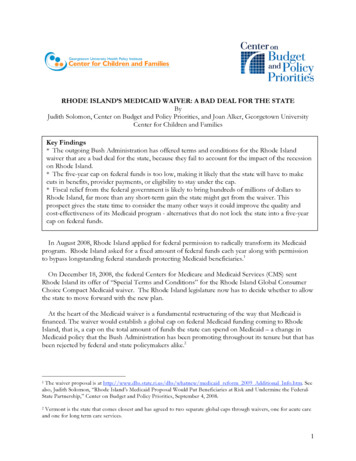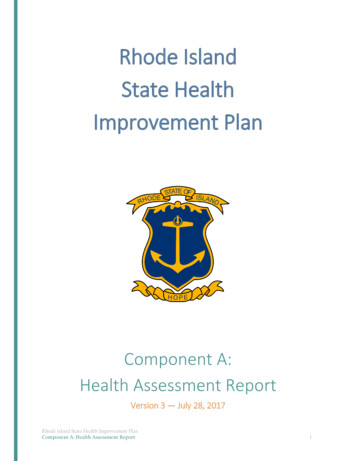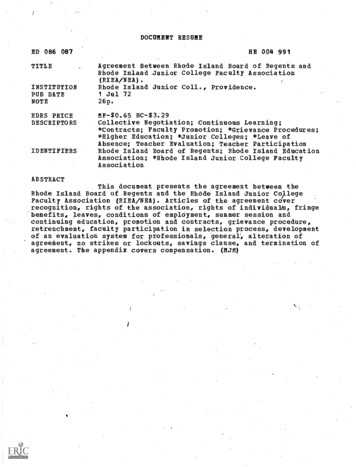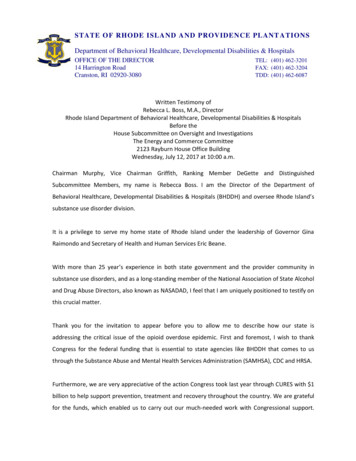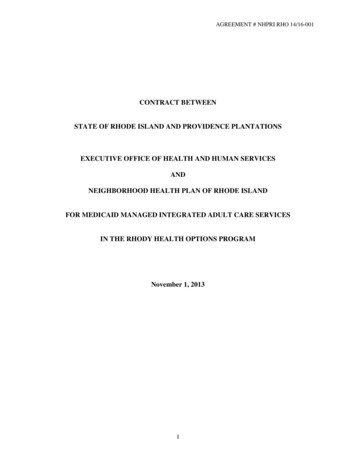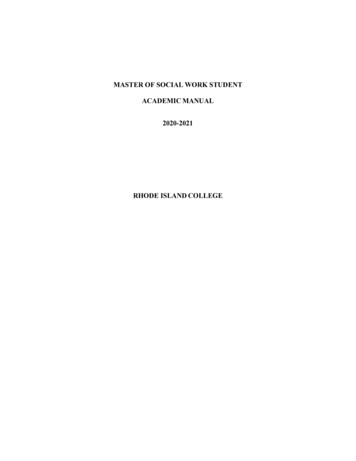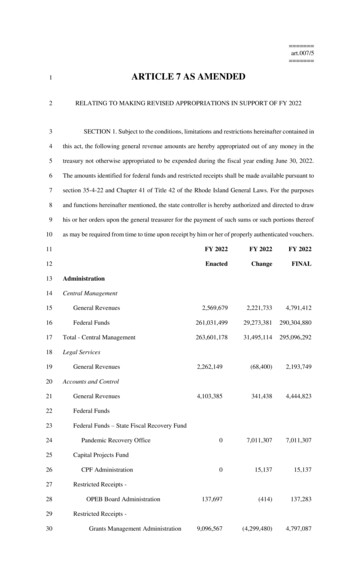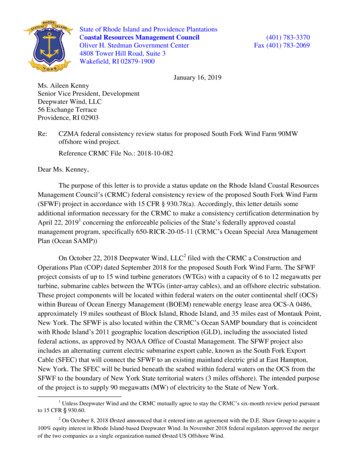
Transcription
State of Rhode Island and Providence PlantationsCoastal Resources Management CouncilOliver H. Stedman Government Center4808 Tower Hill Road, Suite 3Wakefield, RI 02879-1900(401) 783-3370Fax (401) 783-2069January 16, 2019Ms. Aileen KennySenior Vice President, DevelopmentDeepwater Wind, LLC56 Exchange TerraceProvidence, RI 02903Re:CZMA federal consistency review status for proposed South Fork Wind Farm 90MWoffshore wind project.Reference CRMC File No.: 2018-10-082Dear Ms. Kenney,The purpose of this letter is to provide a status update on the Rhode Island Coastal ResourcesManagement Council’s (CRMC) federal consistency review of the proposed South Fork Wind Farm(SFWF) project in accordance with 15 CFR § 930.78(a). Accordingly, this letter details someadditional information necessary for the CRMC to make a consistency certification determination byApril 22, 20191 concerning the enforceable policies of the State’s federally approved coastalmanagement program, specifically 650-RICR-20-05-11 (CRMC’s Ocean Special Area ManagementPlan (Ocean SAMP))On October 22, 2018 Deepwater Wind, LLC2 filed with the CRMC a Construction andOperations Plan (COP) dated September 2018 for the proposed South Fork Wind Farm. The SFWFproject consists of up to 15 wind turbine generators (WTGs) with a capacity of 6 to 12 megawatts perturbine, submarine cables between the WTGs (inter-array cables), and an offshore electric substation.These project components will be located within federal waters on the outer continental shelf (OCS)within Bureau of Ocean Energy Management (BOEM) renewable energy lease area OCS-A 0486,approximately 19 miles southeast of Block Island, Rhode Island, and 35 miles east of Montauk Point,New York. The SFWF is also located within the CRMC’s Ocean SAMP boundary that is coincidentwith Rhode Island’s 2011 geographic location description (GLD), including the associated listedfederal actions, as approved by NOAA Office of Coastal Management. The SFWF project alsoincludes an alternating current electric submarine export cable, known as the South Fork ExportCable (SFEC) that will connect the SFWF to an existing mainland electric grid at East Hampton,New York. The SFEC will be buried beneath the seabed within federal waters on the OCS from theSFWF to the boundary of New York State territorial waters (3 miles offshore). The intended purposeof the project is to supply 90 megawatts (MW) of electricity to the State of New York.1Unless Deepwater Wind and the CRMC mutually agree to stay the CRMC’s six-month review period pursuantto 15 CFR § 930.60.2On October 8, 2018 Ørsted announced that it entered into an agreement with the D.E. Shaw Group to acquire a100% equity interest in Rhode Island-based Deepwater Wind. In November 2018 federal regulators approved the mergerof the two companies as a single organization named Ørsted US Offshore Wind.
The proposed SFWF project is subject to CRMC federal consistency review authoritypursuant to the federal Coastal Zone Management Act (CZMA) at 16 USC § 1456(c)(3)(A) and theCZMA’s implementing regulations at 15 CFR Part 930, Subpart D - Consistency for ActivitiesRequiring a Federal License or Permit and Subpart E - Consistency for Outer Continental Shelf(OCS) Exploration, Development and Production Activities. The SFWF project meets the definitionof a “large-scale offshore development” as specified in § 11.3(H)(1)3.Included within Section 1.3.4 of the COP was a general statement of Coastal ZoneManagement Act consistency with the State’s enforceable policies. See COP at 1-34. As you know, Iindicated to you via email dated October 24, 2018 that the consistency certification included withinthe COP was not in compliance with 15 CFR § 930.57. Additionally, the COP statement concerningDeepwater Wind’s voluntary filing of the consistency certification with the state of Rhode Island wasalso incorrect. As stated in my October 24 email, Deepwater Wind is subject to CRMC federalconsistency review and is required to file a consistency certification with Rhode Island, pursuant to15 CFR Part 930 Subpart D, because the proposed project is a listed activity on the State’s approvedfederal consistency list, and the project is located within Rhode Island’s GLD. In addition to theproper consistency certification statement, my email of October 24 also requested a draft fisheriesmonitoring plan that outlines the specifics as to what species will be monitored and what methodswill be used and when the surveying will be conducted to demonstrate compliance with enforceablepolicy § 11.10.9(C)(1). I had requested that the information be provided to the CRMC prior byTuesday, November 13, 2018 to avoid the CRMC having to issue an incomplete submission noticepursuant to 15 CFR § 930.60, which would stop the agency’s six-month CZMA review period.Deepwater Wind submitted the requested information to the CRMC on November 13, 2018via email and a hardcopy package via FedEx the following day. In review of the package filed byDeepwater Wind, we have determined that it satisfactorily addresses the consistency certificationstatement. See revised Appendix A at A-2 dated November 10, 2018. The fisheries monitoring plantitled “Demersal Fisheries Resources Survey Protocol” was stamped “DRAFT” and it outlines theminimum information necessary to proceed with review. However, the fisheries monitoring planlacks specificity and is insufficient to develop a pre-construction baseline data set necessary to assesstargeted commercial fisheries species that are typically harvested from the project area. A morerobust monitoring plan as detailed below in Section A will be required for the CRMC review.A.Supplemental information required to address Rhode Island’s enforceable policiesThe regulatory standards contained within 650-RICR-20-05-11 are the enforceable policiesfor purposes of the CZMA federal consistency provisions, specifically Part 11.10. These standards inaddition to other applicable federally approved Rhode Island Coastal Resources Management3The enforceable policies of the Rhode Island coastal management program applicable to the SFWF project arecontained in the CRMC’s Ocean Special Area Management Plan, which is codified in the Rhode Island Code ofRegulations as 650-RICR-20-05-11. For purposes of federal consistency, enforceable policies are defined at 15 CFR §930.11(h).2
Program (CRMP) enforceable policies are the basis for the CRMC’s CZMA federal consistencycertification concurrence or objection.§ 11.10.1(C): Offshore Developments shall not have a significant adverse impact on thenatural resources or existing human uses of the Rhode Island coastal zone, as described in the OceanSAMP. In making the evaluation of the effect on human uses, the Council will determine, for example,if there is an overall net benefit to the Rhode Island marine economic sector from the development ofthe project or if there is an overall net loss. Where the Council determines that impacts on the naturalresources or human uses of the Rhode Island coastal zone through the pre-construction,construction, operation, or decommissioning phases of a project constitute significant adverse effectsnot previously evaluated, the Council shall, through its permitting and enforcement authorities instate waters and through any subsequent CZMA federal consistency reviews, require that theapplicant modify the proposal to avoid and/or mitigate the impacts or the Council shall deny theproposal.Deepwater Wind’s response to this enforceable policy states that “The SFWF [SFEC] isconsistent with this policy. The SFWF [SFEC] will not have significant adverse impact on the naturalresources or human uses of the RI Ocean SAMP study area. It is expected that current activities willbe able to continue post construction.” See Appendix A-2 at A-2-1. While current activities may wellcontinue post construction, it is still is not clear whether there may need to be modifications to theproposed project to avoid potential significant impacts to Rhode Island-based commercial fisheryoperations. Therefore, the CRMC cannot at this time conclude that the project is consistent with thisenforceable policy.Figure 1.1-2 of the SFWF COP shows a grid layout with north-south and east-west orientationof the WTGs within a “maximum work area” in context with Deepwater Wind’s lease area OCS-A0486. Inset details show both 0.8 mile and 1.0 mile spacing of the WTGs within a maximum workarea boundary. It appears that Deepwater Wind has committed to an east-west layout of the projectbased on representations by Deepwater Wind staff at the August 27, 2018 CRMC Fishermen’sAdvisory Board meeting and the BOEM public scoping meeting for the SFWF project held onNovember 8, 2018 in Narragansett, RI. Deepwater Wind to date has confirmed that the maximumspacing between WTGs will be 1.0 (statute) mile. As you know, the alternative wind farm layoutproposal developed by the Commercial Fisheries Center of Rhode Island (CFCRI), and included inthe CRMC’s 3-month letter to Vineyard Wind for their proposed 800MW project, consists of a gridof east-west lanes with 1 nautical mile (1 nm) spacing between the WTGs. The alternative wind farmlayout proposal was developed by CFCRI so that if adopted by the offshore wind energy industry forsouthern New England waters, then a majority of Rhode Island-based commercial fishing operationswould be able to continue harvesting activities with some exceptions and adjustments, and coexistwith the offshore wind energy industry. I would encourage Deepwater Wind to consider increasingthe spacing between WTGs to 1 nautical mile to achieve the spacing necessary for consistency withthe CFCRI proposal in an attempt to accommodate the commercial fishing industry and avoidpotential adverse impacts. Furthermore, from a risk management perspective it is imperative thatwind turbines be installed by all renewable energy developers throughout southern New England3
waters in a consistent grid pattern of east-west orientation with a minimum 1 nm spacing betweenturbines to enhance safe navigation and operations of all recreational and commercial vessels.Based on the experience of the Block Island wind farm construction it became evident thatburial depth of the export cable was insufficient in some locations, which necessitated the installationof concrete mats to protect the cable. Considering that the SFEC will be installed in an area of highmobile gear activity it will be important to achieve proper cable burial depth to avoid unnecessary useof cable protection that has a potential to snag mobile gear (trawling nets). It appears that DeepwaterWind is considering the use of self-propelled mechanical and hydraulic trenchers based on discussionin the COP in section 4.1.2.2 and the submarine cable installation drawing contained in Appendix G2to achieve the targeted cable burial depth of 1.2 to 1.8 meters. However, the SFWF COP indicatesthat articulated concrete mattresses or rock placement will be used to protect cables where sea bedconditions may not allow burial to the desired depth within the inter-array cable route or the SFECroute. See COP at 3-31 and 3-45. Deepwater should confirm that the described equipment will beused to the maximum extent practicable and limit the use of hydro-jet plow trenching equipment tosea bed areas that are suitable for such equipment (e.g., predominantly sands). Achieving propercable burial depth and minimizing the use of cable protection will aid in avoiding impacts to thecommercial fishing sector.Given a positive outcome with the issues detailed above, the CRMC could then likelyconclude that the SFWF project has been modified to avoid unnecessary impacts and meets its burdenof proof under enforceable policy § 11.10.1(C).§ 11.10.1(I): The Council recognizes that moraine edges, as illustrated in Figures 3 and 4 in§ 11.10.2 of this Part, are important to commercial and recreational fishermen. In addition to thesemapped areas, the FAB may identify other edge areas that are important to fisheries within aproposed project location. The Council shall consider the potential adverse impacts of futureactivities or projects on these areas to Rhode Island’s commercial and recreational fisheries. Whereit is determined that there is a significant adverse impact, the Council will modify or deny activitiesthat would impact these areas. In addition, the Council will require assent holders for offshoredevelopments to employ micro-siting techniques in order to minimize the potential impacts of suchprojects on these edge areas.§ 11.10.1(J): The finfish, shellfish, and crustacean species that are targeted by commercialand recreational fishermen rely on appropriate habitat at all stages of their life cycles. While all fishhabitat is important, spawning and nursery areas are especially important in providing shelter forthese species during the most vulnerable stages of their life cycles. The Council shall protect sensitivehabitat areas where they have been identified through the Site Assessment Plan or Construction andOperation Plan review processes for offshore developments as described in § 11.10.5(C) of this Part.§ 11.10.2(A): Areas of Particular Concern (APCs) have been designated in state watersthrough the Ocean SAMP process with the goal of protecting areas that have high conservationvalue, cultural and historic value, or human use value from large-scale offshore development. These4
areas may be limited in their use by a particular regulatory agency (e.g., shipping lanes), or haveinherent risk associated with them (e.g., unexploded ordnance locations), or have inherent naturalvalue or value assigned by human interest (e.g., glacial moraines, historic shipwreck sites). Areas ofParticular Concern have been designated by reviewing habitat data, cultural and historic featuresdata, and human use data that has been developed and analyzed through the Ocean SAMP process.Currently designated Areas of Particular Concern are based on current knowledge and availabledatasets; additional Areas of Particular Concern may be identified by the Council in the future asnew datasets are made available. Areas of Particular Concern may be elevated to Areas Designatedfor Preservation in the future if future studies show that Areas of Particular Concern cannot riskeven low levels of large-scale offshore development within these areas. Areas of Particular Concerninclude:1. Areas with unique or fragile physical features, or important natural habitats;2. Areas of high natural productivity;3. Areas with features of historical significance or cultural value;4. Areas of substantial recreational value;5. Areas important for navigation, transportation, military and other human uses; and6. Areas of high fishing activity.Glacial moraines of the cobble and boulder nature represent areas of high biodiversity andimportant fish habitat. Impacts to these areas could result in long-term or permanent impacts to fishpopulations that are dependent on these habitat types and thus impact the Rhode Island fishery in thearea. Additionally, the CRMC is obligated through § 11.10.1(J) to protect sensitive habitat areaswhere they have been identified through the Site Assessment Plan or Construction and OperationPlan review processes. The Ocean SAMP has identified specific glacial moraines as areas ofparticular concern (APC) as shown in §§ 11.10.2(F) and (G), Figures 3 and 4, respectively.Deepwater Wind’s COP indicates that the project is consistent with the enforceable policy and thatthe project has been sited to avoid any areas of particular concern, including moraine edges. See COPAppendix A-2 at A-2-2. While the project may not be located within a glacial moraine, there is nographic or other evidence within the COP that clearly shows that the project is not located within aglacial moraine as depicted within §§ 11.10.2(F) and (G) of the Ocean SAMP. Even if shown that theproject is not sited within an existing identified moraine or moraine edge, “the FAB may identifyother edge areas that are important to fisheries within a proposed project location” pursuant to §11.10.1(I) as part of the CRMC review process. An appropriate graphic is requested showing theproject in relation to existing glacial moraines mapped within the Ocean SAMP as indicated above.Some of the Ocean SAMP geological mapping and data are available at the www.narrbay.org websitehere: http://www.narrbay.org/d projects/oceansamp/.The CRMC may identify additional Areas of Particular Concern as new datasets are madeavailable, as provided by § 11.10.2(A). The more detailed geotechnical survey data collected byDeepwater Wind for the SFWF/SFEC project would likely be helpful in establishing whether eitherproject element is located within a moraine or APC, or whether the project is located within sensitive5
habitat areas as may be identified by the CRMC. Accordingly, absent additional information andconsideration by the FAB and the CRMC pursuant to §§ 11.10.1(I), 11.10.1(J) and 11.10.2(A), theCRMC at this time cannot conclude that the SFWF/SFEC project is not located within a moraine, anAPC or sensitive habitat areas. Therefore, the CRMC presently does not agree that the SFWF andSFEC are consistent with the enforceable policies of §§ 11.10.1(I) and 11.10.2(A) as stated withinDeepwater Wind’s Appendix A-2.§ 11.10.9(C): The items listed below shall be required for all offshore developments:1. A biological assessment of commercially and recreationally targeted species shall berequired within the project area for all offshore developments. This assessment shall assess therelative abundance, distribution, and different life stages of these species at all four seasons of theyear. This assessment shall comprise a series of surveys, employing survey equipment and methodsthat are appropriate for sampling finfish, shellfish, and crustacean species at the project’s proposedlocation. Such an assessment shall be performed at least four times: pre-construction (to assessbaseline conditions); during construction; and at two different intervals during operation (i.e. one (1)year after construction and then post-construction). At each time this assessment must capture allfour seasons of the year. This assessment may include evaluation of survey data collected through anexisting survey program, if data are available for the proposed site. The Council will not require thisassessment for proposed projects within the renewable energy zone that are proposed within two (2)years of the adoption of the Ocean SAMP.As you know, I had advised you in my October 24, 2018 email that the COP filed with theCRMC on October 22, 2018 indicated that Deepwater Wind was developing a fisheries monitoringplan to further assess targeted species for pre-construction, during construction and under operationalconditions. Thus, a fisheries monitoring plan was not yet completed for CRMC review. DeepwaterWind provided to the CRMC on November 13, 2018 a fisheries monitoring plan titled “DemersalFisheries Resources Survey Protocol” that was stamped “DRAFT”. The submitted fisheriesmonitoring plan essentially details a gillnet survey for demersal fish species, but it lacks specificity todevelop a comprehensive pre-construction baseline data set necessary to assess targeted commercialfisheries species that are typically harvested from the area. Moreover, the gillnet survey design isinsufficient to establish a baseline assessment of demersal finfish. In addition, an assessment andmonitoring plan for commercially harvested crustacean species must be included as part of thebiological assessment. Pelagic fish and molluscan shellfish are known to be present in the projectarea and should be included in the assessment and monitoring plan. In conclusion, a more robustmonitoring plan will be required for the CRMC review that outlines the specifics as to what specieswill be monitored and what methods will be used and when the surveying will be conducted todemonstrate compliance with enforceable policy § 11.10.9(C)(1).B.ConclusionPursuant to the enforceable policies of the Ocean SAMP, offshore developments shall nothave a significant adverse impact on the natural resources or existing human uses of the Rhode Islandcoastal zone. Where the CRMC determines that there are significant adverse effects on Rhode Island6
coastal resources or uses, it can require that the applicant modify the proposal to avoid and/ormitigate the impacts or the CRMC shall deny the proposal. See Ocean SAMP § 11.10.1(C). Asdetailed above, there is further information necessary for Deepwater Wind to file with the CRMC toproperly evaluate potential coastal effects to the Rhode Island-based commercial fishing operations.I am requesting that Deepwater Wind provide the following data and information withinthirty (30) days from the date of this letter to demonstrate that the SFWF/SFEC project isconsistent with the enforceable policies of the Ocean SAMP at § 11.10. Absent this informationwithin the CRMC’s review period, presently scheduled to end on April 22, 2019, the CRMC wouldbe unable to conclude that the SFWF/SFEC project is consistent with the Rhode Island coastalmanagement program. Thus, the CRMC would then have to object to Deepwater Wind’s consistencycertification pursuant to 15 CFR §§ 930.63(c) and 930.78.Additional data and information necessary for CRMC review1. Alternative layout showing an increase in spacing between WTGs to 1 nautical mile.2. Confirmation as to what specific trenching equipment, hydraulic or mechanical, will beused and under what conditions, and to limit the use of hydro-jet plow trenching only tosea bed areas that are suitable for such equipment (e.g., predominantly sands) to ensureachievement of proper cable burial depth and minimize the use of cable protection(concrete mats or rock) to avoid adverse impacts to the commercial fishing sector.Deepwater should identify specific areas of sea bed where specific trenching techniqueswill likely be used.3. Supply a graphic(s) showing the proposed SFWF and SFEC project elements in relation tothe currently existing CRMC identified glacial moraines as depicted within §§ 11.10.2(F)and (G) of the Ocean SAMP. Additional non-confidential geotechnical data should befiled with the CRMC to aid in determining whether the SFWF/SFEC is located within aglacial moraine a moraine edge or an area of particular concern.4. A more robust fisheries monitoring plan that details the specifics as to what commercialand recreational species will be monitored, what survey methods will be used and whenthe surveying will be conducted to meet the requirement of a biological assessment of therelative abundance, distribution, and different life stages of these species at all fourseasons of the year. The assessment must comprise a series of surveys, using surveyequipment and methods appropriate for sampling finfish, shellfish, and crustacean speciesat the project’s proposed location. The assessment must be performed at least four times:pre-construction (to assess baseline conditions); during construction; and at two differentintervals during operation (i.e. one (1) year after construction and then post-construction)and must capture all four seasons of the year.A final decision by the CRMC for concurrence or objection to Deepwater Wind’s SFWFconsistency certification must be issued by April 22, 2019 pursuant to 15 CFR §§ 930.62, 930.63 and930.78. Should Deepwater Wind require additional time to prepare and file the requested information7
The purpose of this letter is to provide a status update on the Rhode Island Coastal Resources Management Council's (CRMC) federal consistency review of the proposed South Fork Wind Farm . includes an alternating current electric submarine export cable, known as the South Fork Export Cable (SFEC) that will connect the SFWF to an existing .
